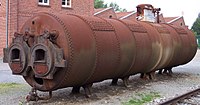
Photo from wikipedia
Abstract To accelerate the deployment of Carbon Capture and Storage (CCS) based on the solid amine adsorbents towards a practical scale application relevant to Natural Gas Combined Cycle (NGCC) power… Click to show full abstract
Abstract To accelerate the deployment of Carbon Capture and Storage (CCS) based on the solid amine adsorbents towards a practical scale application relevant to Natural Gas Combined Cycle (NGCC) power plants, this study has evaluated the cyclic performance of a polyethylenimine/silica adsorbent of kg scale in a laboratory scale bubbling fluidized bed reactor. A high volumetric concentration 80−90 vol% of steam mixed with N2 and CO2 has been used as the stripping gas during a typical temperature swing adsorption (TSA) cycle. Both the simulated NGCC flue gas and the actual flue gas from a domestic gas boiler have been used as the feed gas of the CO2 capture tests with the solid adsorbent. Various characterization has been carried out to elucidate the possible reasons for the initial capacity decline under the steam regeneration conditions. The effect of presence of CO2 in the stripping gas has also been studied by comparing the working capacities using different regeneration strategies. It has been demonstrated that the breakthrough and equilibrium CO2 adsorption capacities can be stabilized at approximately 5.9 wt% and 8.6 wt%, respectively, using steam regeneration for both the simulated and actual natural gas boiler flue gases. However, using a concentration of 15 vol% CO2 in the stripping gas has resulted in a significantly low working capacity at a level of 1.5 wt%, most likely due to the incomplete CO2 desorption and degradation in a CO2 containing environment.
Journal Title: International Journal of Greenhouse Gas Control
Year Published: 2020
Link to full text (if available)
Share on Social Media: Sign Up to like & get
recommendations!